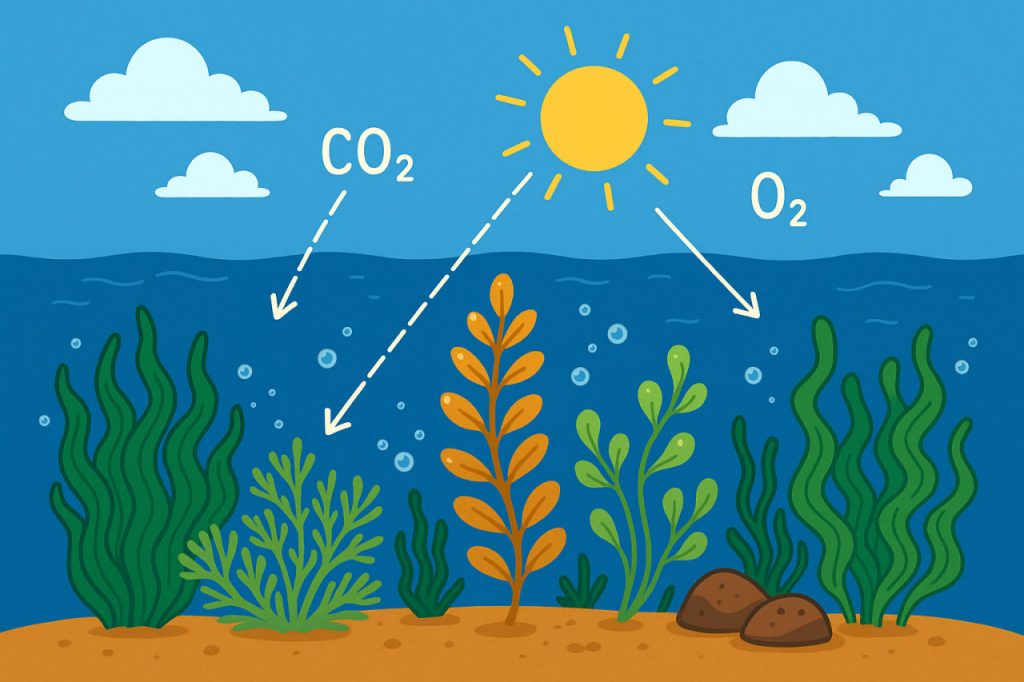Algae, though often overlooked, play a central role in producing oxygen and maintaining the health of the planet’s oceans. These aquatic organisms act much like terrestrial plants by converting sunlight and carbon dioxide into energy through photosynthesis, a process that also releases oxygen as a byproduct. In fact, a majority of the Earth’s oxygen comes not from forests, but from microscopic algae floating in seawater.
Photosynthesis in Algae
Algae absorb sunlight, carbon dioxide (CO₂), and nutrients dissolved in water to carry out photosynthesis. This process converts solar energy into chemical energy and releases oxygen (O₂) as a natural output. Unlike land plants, algae do not need roots or leaves to function; instead, their entire surface is capable of absorbing light and gases.
Photosynthesis occurs mainly in the photic zone—the upper layer of the ocean where sunlight can penetrate. In this zone, especially in nutrient-rich waters, phytoplankton, which are microscopic algae, thrive and constantly produce oxygen. These organisms are so numerous that, collectively, they contribute to over 50% of the oxygen in Earth’s atmosphere.
Role of Phytoplankton
Phytoplankton are tiny, single-celled algae that drift near the ocean’s surface. Though individually microscopic, they form vast blooms visible from space. These organisms are primary producers in marine food chains, supporting fish, whales, and other marine life.
As phytoplankton photosynthesize, they not only produce oxygen but also absorb large quantities of carbon dioxide. This helps regulate global carbon levels and contributes to the carbon cycle. Oxygen released by these organisms dissolves in the ocean and diffuses into the atmosphere, benefiting both aquatic and terrestrial life.
Macroalgae and Coastal Ecosystems
In addition to phytoplankton, macroalgae—such as seaweeds and kelp—also contribute significantly to oxygen production. These larger algae species are typically found near coastlines, where light is abundant and water movement helps distribute nutrients.
Kelp forests, for example, are some of the most productive marine ecosystems on Earth. They support high levels of biodiversity and enrich the water with oxygen through continuous photosynthesis. These ecosystems not only benefit marine animals but also help improve water quality.
Impact on Ocean Health
Algae-produced oxygen is vital for the survival of aerobic marine organisms, such as fish, mollusks, and crustaceans. In areas where algae are abundant, oxygen levels are usually high, promoting biodiversity. However, disruptions such as pollution or climate change can lead to harmful algal blooms or reduce photosynthetic activity, causing hypoxia—low oxygen levels—in coastal waters.
Maintaining the balance of healthy algae populations is essential to preserving oxygen levels in marine ecosystems. Excessive nutrient runoff from agriculture, for instance, can trigger explosive growth of certain algae, eventually leading to oxygen depletion when they die and decompose.
Global Importance of Algal Oxygen Production
The oxygen generated by algae is not confined to the ocean. Much of it escapes into the atmosphere, making algae a global oxygen supplier. In fact, scientists estimate that more than half of the breathable oxygen on Earth originates from marine algae, not forests.
This makes the protection of ocean ecosystems and the reduction of pollution and climate impacts vital not only for marine health but also for human survival. Supporting ocean research and reducing emissions are key strategies to ensure the continued role of algae as the Earth’s natural oxygen generators.
Conclusion
Algae are fundamental to life on Earth due to their massive contribution to oxygen production through photosynthesis. From microscopic phytoplankton to massive kelp forests, these organisms enrich the ocean and atmosphere alike. Understanding and protecting algae is essential to ensuring the stability of marine ecosystems, the climate, and the breathable air we all depend on.
Glossary
- Algae — aquatic organisms capable of photosynthesis, ranging from microscopic phytoplankton to large seaweeds.
- Photosynthesis — a process by which organisms convert sunlight and carbon dioxide into energy, releasing oxygen.
- Phytoplankton — microscopic algae that float near the ocean surface and form the base of marine food chains.
- Carbon cycle — the process through which carbon is exchanged among the atmosphere, oceans, and living organisms.
- Macroalgae — larger species of algae, such as seaweed and kelp.
- Aerobic — organisms or processes that require oxygen to survive.
- Hypoxia — a condition where oxygen levels in water are dangerously low.
- Photic zone — the upper layer of a body of water where sunlight penetrates and photosynthesis can occur.


